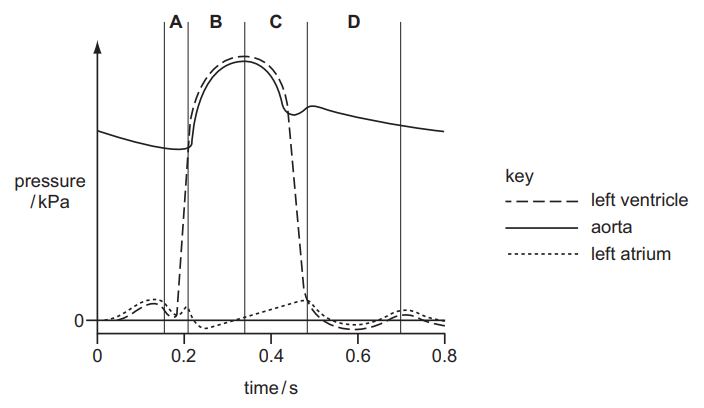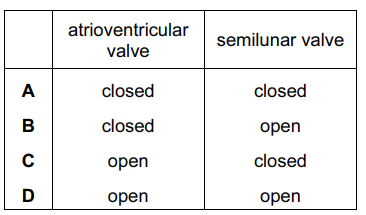Question
During the cardiac cycle, the movement of the valves causes sounds that can be heard using a stethoscope.
What causes the first sound after atrial systole in the cardiac cycle?
- closing of the atrioventricular valves
- opening of the semilunar valves
- closing of the semilunar valves
A 1 and 2 B 1 and 3 C 1 only D 3 only
▶️Answer/Explanation
The first sound heard in the cardiac cycle after atrial systole is caused by the closing of the atrioventricular valves. This sound is known as the “lub” sound and represents the beginning of ventricular systole. The closing of the atrioventricular valves prevents the backflow of blood from the ventricles into the atria during ventricular contraction.
Option A is incorrect because the opening of the semilunar valves occurs during ventricular systole, which is after the first sound has been heard. Option B is incorrect because the opening of the semilunar valves occurs during ventricular systole, which is after the first sound has been heard. Option D is incorrect because the closing of the semilunar valves occurs after the second sound has been heard, which is the sound caused by the closing of the semilunar valves.
Question
The graph shows the pressure in three parts of the heart during one cycle.

At 0.2 seconds, which part of the heart is responding to the excitatory stimulus?

Answer/Explanation
Answer C
The correct answer is C.
Atrial systole: continues for about 0.1 seconds. Ventricular systole: continues for about 0.3 seconds. Atrial diastole: continues for about 0.7 seconds. Ventricular diastole: continues for about 0.5 seconds.
Question
The diagram shows the pressure changes in various structures of the left side of the heart during the cardiac cycle.
At the end of which period, A, B, C or D, is the ventricle full of blood?

Answer/Explanation
Ans: A
Systole refers to the phase of the cardiac cycle during which the heart contracts, pumping oxygenated blood from the left ventricle into the aorta and systemic circulation, and deoxygenated blood from the right ventricle into the pulmonary trunk and lungs where it is subsequently oxygenated.
The ventricles of the heart have thicker muscular walls than the atria. This is because blood is pumped out of the heart at greater pressure from these chambers compared to the atria. The left ventricle also has a thicker muscular wall than the right ventricle. This is due to the higher forces needed to pump blood through the systemic circuit (around the body) compared to the pulmonary circuit.
Hence, the correct option is A.
Question
Which statement about coronary by-pass surgery is correct?
- It is carried out to reduce the effects of atherosclerosis, improving the delivery of oxygen and dissolved glucose to the cardiac muscle of the heart.
- It is the surgical removal of one or more coronary arteries to reduce the strain on the heart of a person with coronary heart disease.
- Surgeons are able to divert blood around the diseased sections of the coronary arteries so that more oxygenated blood can be pumped round the systemic circulation.
- The diseased parts of the aorta are replaced by using a section of a main artery from elsewhere in the body of the same person, to avoid rejection.
Answer/Explanation
Ans:
A
The correct, option A is the correct answer. Coronary bypass surgery is carried out to reduce the effects of atherosclerosis, improving the delivery of oxygen and dissolved glucose to the cardiac muscle of the heart. The procedure involves the surgeon using a healthy blood vessel from another part of the body to create a new path for blood to flow to the heart. This helps to improve blood flow and reduce chest pain. Option B is incorrect because it describes a different procedure called coronary artery removal. Option C is incorrect because it is not an accurate description of the procedure. Option D is incorrect because it describes a different type of surgery.
Question
During a cardiac cycle, the pressure in the right ventricle is lower than that in the right atrium and lower than that in the pulmonary artery.
Which row is correct?

Answer/Explanation
Ans:
C
The correct, option C is the correct answer. During the cardiac cycle, the pressure in the right ventricle is lower than that in the right atrium, but higher than that in the pulmonary artery. The pressure in the right atrium is lower than that in the right ventricle during ventricular diastole, but higher than that in the vena cava. The pressure in the pulmonary artery is higher than that in the right ventricle, but lower than that in the aorta. Option A is incorrect because the pressure in the right ventricle is actually higher than that in the right atrium during ventricular systole. Option B is incorrect because the pressure in the right ventricle is actually higher than that in the right atrium. Option D is incorrect because it describes the pressure relationship between the left ventricle and the aorta, not the right ventricle and the pulmonary artery.
